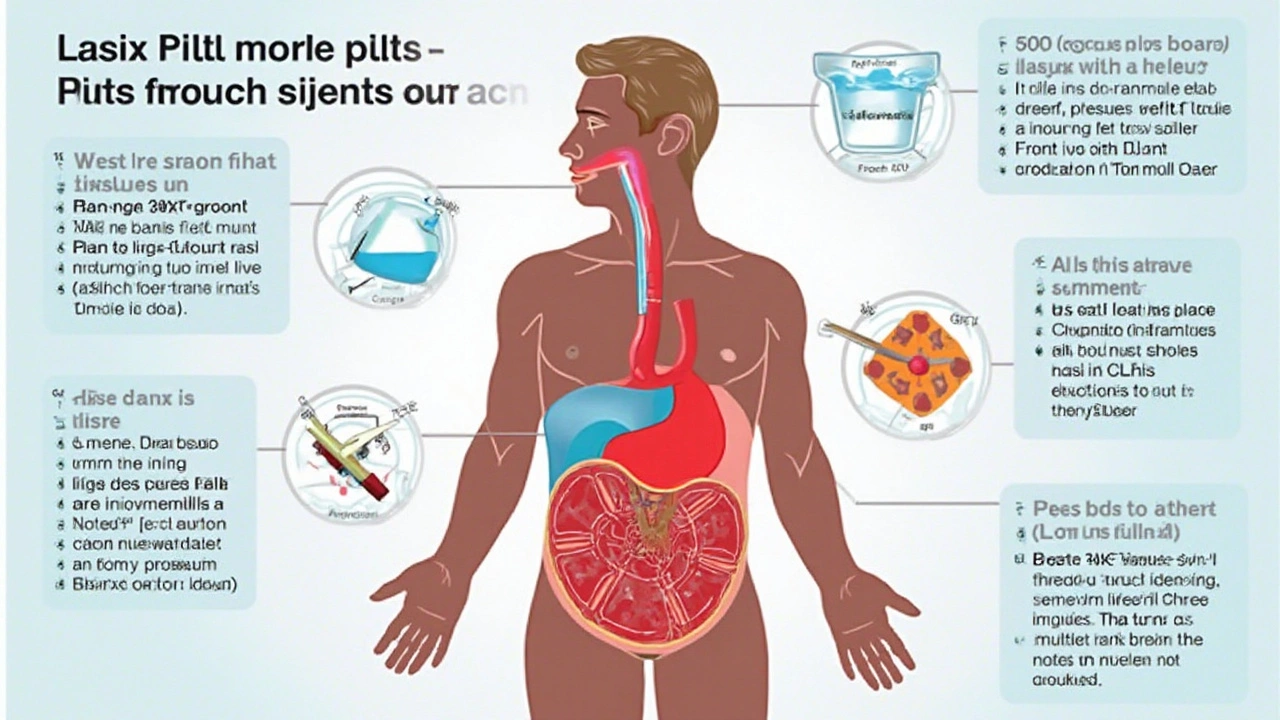Weird to think a pill could pull pounds of water out of you in a single day, but that's the reality for people taking Lasix. This isn’t some go-to weight loss trick from TikTok—this powerful little tablet, also known as furosemide, makes your kidneys work overtime, turning your bathroom into your new best friend. Lasix is essential for many, especially if you’re fighting to keep your heart, lungs, and legs from filling up with extra water. But, like every medication that really works, it comes with more than its fair share of baggage. Stick around if you want to get real about Lasix: the reasons people need it, what to expect, and how to sidestep problems that don’t get spelled out on the label.
What is Lasix and Why Does It Matter?
Lasix (generic name: furosemide) isn’t just a random drug; it’s one of the most prescribed diuretics in the world. Hospitals stock it as a staple on carts, and older adults with heart issues might know it better than their morning coffee. The main job of Lasix is to make your body get rid of salt and water—fast. This is helpful if your body, for one reason or another, just keeps holding onto fluid. Think of situations where someone’s ankle looks like a water balloon, their stomach feels stretched, or they’re struggling to breathe because there’s fluid backing up into their lungs. That’s where Lasix steps in.
The technical details? Lasix targets the kidneys, blocking a little transporter called NKCC2 in the loop of Henle—a twisty bit of the kidney you’d only remember from biology class if you were a nerd like me in high school. By blocking this transporter, Lasix stops the body from reabsorbing sodium, and since water always follows sodium, you pee out both. The result: rapid and serious loss of water and sodium in the urine.
Lasix is absolutely crucial for people with congestive heart failure, where the heart just can’t keep up, and the lungs or legs start swelling. It’s also standard for severe high blood pressure, liver cirrhosis with massive fluid buildup (ascites), and kidney disease with edema. It’s not a casual drug, but for many, it’s basically the reason they can walk, breathe, or sleep without drowning in their own fluids.
Lasix even gets used in creative medical emergencies—like in hypercalcemia (too much calcium in the blood), some poisonings where you want the kidneys to flush out nasty stuff faster, or in serious cases of high blood pressure that need to drop now, not tomorrow.
Inside the Life of a Lasix User: What Taking Lasix Really Feels Like
Let’s get personal for a minute. My aunt, Margaret, is on Lasix every single morning for her stubborn heart. I grew up watching her rush to the bathroom during every Sunday brunch; if you time it, you could set your clock by Margaret’s post-Lasix pee break. But it’s not just about peeing a lot. For people on Lasix, there’s a whole daily routine around it.
The drug usually starts working within an hour after swallowing the pill, and trust me, you will feel it. Some folks compare it to opening the floodgates. If someone’s on an IV dose in the hospital, the effect can hit even faster—sometimes in minutes. That’s why hospitals warn you: “Call for help before getting up!” It’s not the moment for a surprise sprint to the bathroom if you’re already unsteady on your feet.
Hydration and timing are big deals. Take Lasix right before bed, and you might be up half the night making trips to the toilet. Doctors usually suggest taking it in the morning so you can actually sleep. People quickly learn to avoid taking it before road trips, movies, or anywhere that requires a bathroom map.
What’s wild: A study in 2022 showed that, on average, a daily 40mg dose could make you lose between 1-2 liters of water in a few hours. That’s basically a large soda bottle. So don’t be shocked if your socks finally stop leaving deep marks on your legs or your shoes feel looser—Lasix is working as promised!
But, it’s not all relief and dry socks. The same power that pulls off fluid can sometimes snatch away important minerals. Low potassium is the big troublemaker. More than 30% of Lasix users will end up needing potassium supplements alongside. Low potassium can make muscles weak, your heartbeat feel strange, or you just feel wiped out—always mention new symptoms to your doctor.

The Highs and Lows: Side Effects and Real Risks of Lasix
Every pill you pop comes with a shadow, and Lasix is no different. Most of the time, side effects are nuisances, but sometimes they’re a warning signal not to ignore. Here’s the breakdown—with facts, not panic:
- Dizzy Spells: When you lose fluid too quickly, your blood pressure can drop hard, especially when you stand up. Cue the room spinning, maybe even a faint.
- Dehydration: It might sound obvious, but some people end up dehydrated because they’re losing more water than they’re taking in. Dry mouth, headaches, and pea-sized amounts of urine are red flags.
- Mineral Imbalance: Besides potassium, Lasix can also drop sodium, calcium, and magnesium. This is where things get complicated—these minerals keep muscles (even your heart!) and nerves zipping along normally.
- Hearing Issues: At really high doses, Lasix has been linked to hearing loss or ringing in the ears (tinnitus). It’s one of the rare but real risks, usually with big IV doses.
- Kidney Effects: Irony alert—Lasix works on the kidneys, but if you get too dry or use it too aggressively, it can hurt them. That’s why chronic users check their labs a lot.
- Gout Attacks: Lasix raises uric acid, so if you’re prone to gout, don’t be surprised if those old attacks flare up more often.
- Allergic Reactions: Like any drug, a tiny slice of users might break out in hives, rashes, or, in rare cases, serious allergic reactions.
Most of these issues show up in people using high doses or those taking Lasix for years. Little tip—if you’re ever told to bump up your Lasix for a few days because of swelling, keep an eye out for side effects and let your doctor know if things feel off. Better safe than sorry.
For number lovers, here’s a quick table showing how common some problems are (based on published trials):
| Side Effect | How Often? |
|---|---|
| Low potassium | 30-40% |
| Dizziness/Low blood pressure | 10-20% |
| Dehydration | Up to 10% |
| Hearing changes (high dose) | <1% |
| Gout attack | 5-10% |
Doctors keep an especially close eye on blood pressure, basic bloodwork (checking sodium, potassium, kidney numbers), and ask about symptoms you might think aren’t related. Ignore that old cliché—yes, tell your doctor even if you “just” feel a little funny.
Safe Use and Smart Tips for Anyone on Lasix
Living with Lasix doesn’t have to be stressful, but you do need a game plan. Over the years, I’ve picked up little tricks from my own family, stories from nurses, and even the occasional wisdom nugget from Julian, who’s always the glass-half-full kind. Here’s what I’d tell anyone, no matter if you’re new to *Lasix* or you’ve been at it for years.
- Timing matters: Take Lasix early in the day, so it doesn’t ruin your sleep. If your dose is split, ask whether you need to take the second dose before dinner—better to spend your nights dreaming than hustling to the bathroom!
- Keep a weight diary: Daily weigh-ins right after waking up (and after your first pee) tell you if you’re suddenly holding on to fluid. A sudden jump—2 pounds or more overnight, or 4 pounds in a week—deserves a call to your healthcare team.
- Mind your potassium: Eat potassium-rich foods (bananas, spinach, oranges), unless you’ve been told otherwise. Some people need prescription potassium supplements or even prescription slow-release tablets.
- Drink but don’t drown: It sounds silly, but don’t “make up” for fluid loss by guzzling water endlessly. Drink to thirst. Too much water can throw salt levels out of balance.
- Keep lab appointments: Skipping bloodwork is a rookie mistake. Regular checks let you spot any brewing trouble before symptoms show up.
- Mark your calendar: Lasix can interact with other meds—especially those for blood pressure, lithium, some antibiotics, or diabetes drugs. If your medication list changes, double-check with your physician or pharmacist.
- Plan big outings around your dose: Heading to a wedding, long car ride, or a doctor’s appointment? Adjust your Lasix with your doc’s blessing, or at least plan extra pee breaks into your schedule.
- Be honest about your symptoms: If you’re feeling dizzy, weak, confused, or have new swelling, call for help. Don’t blame it on “getting older.”
- Don’t stop suddenly: Sometimes people just get tired of the hassle and go off Lasix on their own. This can cause major swelling, high blood pressure, or shortness of breath. Always talk to your doctor first about changing your dose.
Lasix isn’t exactly a ‘set it and forget it’ drug. It takes a thoughtful approach, support from family (or spouse—hey Julian!), and a willingness to treat your bathroom like a home base. If you use these tips, the annoying parts fade, and the benefits shine through.

Lasix in Perspective: Real Data, Common Questions, and the Science Behind the Scenes
Let’s zoom out for a second—why all this fuss about one little pill? Lasix is on the World Health Organization’s List of Essential Medicines. That alone says a lot about its value globally. Millions use it safely every single day, but there’s always buzz on what’s changing, what’s risky, and what’s new in the world of diuretics.
Research is ongoing about long-term Lasix use. More recent studies point out that while Lasix is great at moving water and keeping symptoms at bay, it hasn’t been shown to actually make people live longer all by itself. In heart failure, it’s more about quality of life—less leg swelling, less breathlessness—not a guaranteed jump in years. That said, it remains *the* frontline for rapid symptom relief.
There are new drugs out there—some fancy SGLT2 inhibitors and other diuretics—but Lasix keeps a special status for its ability to work fast and predictably. Hospitals keep it right beside the crash cart for a reason.
You might wonder about the future: Will Lasix be replaced? For now, the answer is not likely. But healthcare providers are getting smarter about when, how, and for whom it’s best used—customizing doses, pairing it with other meds, or even using lower doses for long-term control.
Got curious questions? Here’s the quick-fire Lasix cheat sheet:
- Can you drink alcohol on Lasix? Better not—alcohol is dehydrating and drops blood pressure, raising the risk for dizziness or passing out.
- Can Lasix treat high blood pressure alone? Not usually, unless there’s fluid overload. It works better for swelling than plain hypertension.
- Are all ‘water pills’ the same? Not really. Lasix is a loop diuretic; there are other types. Each works a bit differently and is picked based on your needs.
- Will Lasix help me lose weight? Only water weight—don’t expect lasting fat loss. Some folks notice a quick drop on the scale, but it’s not a permanent fix.
- Can you take Lasix if you’re allergic to sulfa drugs? There’s a tiny risk, but most people who react to sulfa antibiotics don’t react to Lasix. Chat with your doc to be sure.
That’s the lowdown on Lasix—no sugarcoating, no scare tactics, just what real people live with every day. If you, your loved ones, or your aunt like Margaret are on this ‘water pill,’ knowing the science and the stories makes a difference you can feel in your bones (or at least in your slippers, once the swelling’s gone).







Hutchins Harbin
June 14, 2025 AT 11:06Let me break down the whole Lasix saga like a Netflix binge, because honestly, this drug is the plot twist you never saw coming. First, it forces your kidneys into overdrive, turning your bladder into the most overworked nightclub bouncer on the planet. You swallow that little tablet and within an hour, you're basically on a water slide that ends at the porcelain throne. The floodgates open, and you lose a liter or two of fluid, making your socks feel like they finally got the memo to loosen up.
But that's just the surface. The real drama kicks in when electrolytes start playing musical chairs – potassium drops, sodium slides, and if you’re not careful, you’ve invited dizziness and fainting to the party. Your heart, which relies on those minerals for rhythm, might start jazzing up in weird ways, leaving you feeling like you’ve just survived a roller coaster without the safety harness.
Now, think about the long‑term side effects: chronic dehydration, kidney strain, even rare auditory issues that can turn your favorite playlist into a constant ring of tinnitus. And let’s not forget gout – that unwelcome guest who shows up when uric acid spikes, making your toe feel like it’s hosting a fireworks show.
On the upside, for people battling heart failure or pulmonary edema, Lasix is the hero that clears the fluid jam, giving them breathing space and a chance to walk without feeling like they’re wading through a swamp.
Bottom line: treat Lasix like a high‑octane sports car – it’s fast, powerful, and exhilarating, but you need a skilled driver (your doctor) and a solid maintenance plan (regular labs, potassium supplements, and timing your doses right). Otherwise, you’ll end up stuck in a ditch of side effects that could have been avoided with a bit of foresight and a dash of common sense.
Benjamin Herod
June 15, 2025 AT 01:00While the foregoing exposition captures the essence of furosemide, one must also consider the socioeconomic implications of widespread diuretic dependency. The pharmaceutical market thrives on chronic administration, yet patients often remain unaware of the intricacies of electrolyte balance.
luemba leonardo brás kali
June 15, 2025 AT 14:53In terms of precise language, the article correctly identifies the NKCC2 transporter as the primary target of Lasix. However, it would benefit from clarifying that the loop of Henle segment impacted is the thick ascending limb, which is essential for accurate medical education.
Corey McGhie
June 16, 2025 AT 04:46Alright, love the practical tips, but let’s get real – timing your dose isn’t just about sleep, it’s about not missing that crucial “bathroom break” during a Netflix marathon. If you pop a 40 mg tablet before the season finale, you’ll be sprinting to the loo halfway through the plot twist. Also, never ignore that sudden drop in blood pressure; it’s basically your body screaming “Whoa, slow down!”-and you’re the one who has to listen.
Ajayi samson
June 16, 2025 AT 18:40Honestly, the whole “water pill” hype is just a marketing ploy to keep patients buying endless refills. The side‑effect list reads like a horror movie, yet doctors brush it off as “normal.” If you’re tired of being a guinea pig, demand stricter monitoring or alternatives before you end up with permanent kidney damage.
Lief Larson
June 17, 2025 AT 08:33Lasix is a big deal because its short term relief can be a lifesaver for folks with heart issues. So if u take it right early in the day u wont be up all night in the bathroom keep an eye on your potassium levels also
Julia Grace
June 17, 2025 AT 22:26Super helpful guide! Just a heads‑up, if you’re on a low‑sodium diet, you might need to tweak your intake a bit – otherwise you could feel weirdly lightheaded. Also, try snacking on a banana or some spinach after your dose; the potassium boost is a real game‑changer.
Sadie Bell
June 18, 2025 AT 12:20Take Lasix in the morning – it’ll save your night.
Noah Bentley
June 19, 2025 AT 02:13Okay, so the article kinda glosses over the fact that you can literally feel like you’re on a desert hike after a dose – dry mouth, low blood pressure, the whole works. If you’re not tracking your vitals, you’re basically flying blind and that’s just lazy.
Kathryn Jabek
June 19, 2025 AT 16:06Esteemed colleagues, whilst the composition delineates the therapeutic merits of Lasix, it neglects to expound upon the ethical ramifications of prescribing such a potent diuretic without exhaustive patient education. One must advocate for comprehensive informed consent, lest we perpetuate a cycle of iatrogenic complications.
Ogah John
June 20, 2025 AT 06:00Right, the article is solid but could have used a bit more sarcasm about “quick fixes.” We all know that dropping a liter of water isn’t sustainable long‑term; it’s like trying to lose weight by standing on a scale for a week – it works temporarily, then reality hits.
Kelvin Murigi
June 20, 2025 AT 19:53Great rundown! One tip: keep a simple spreadsheet of your daily weight and potassium intake. Seeing the numbers helps you catch trends before you end up dizzy on the couch.
ahmad matt
June 21, 2025 AT 09:46Wow, another “water pill” article with no real critique. If you’re serious about health, you should call out the pharmaceutical push that keeps people on high doses forever. Otherwise it’s just a glossy PR piece.
kristine ayroso
June 21, 2025 AT 23:40Honestly this article could use a bit more cultural perspective – in many countries patients get Lasix without proper labs, leading to big issues. We need to push for global standards, not just US‑centric advice.
Ben Small
June 22, 2025 AT 13:33Spot on! If you keep that weight diary, you’ll spot fluid shifts faster than your doctor does. Also, never skip that potassium supplement – it’s a game‑changer.
Dylan Hilton
June 23, 2025 AT 03:26Love the detailed guide! I’d add a reminder: always double‑check interactions with blood pressure meds – the combo can send your BP plummeting.
Christian Andrabado
June 23, 2025 AT 17:20Sure, the article is “nice,” but it skips over the fact that many patients get prescribed Lasix without any education. That’s a serious oversight.
Chidi Anslem
June 24, 2025 AT 07:13Very thorough! From a global health standpoint, it’s crucial to note that access to regular lab monitoring isn’t universal, making safe Lasix use a challenge in low‑resource settings.
Holly Hayes
June 24, 2025 AT 21:06Honestly this read feels like a lecture from 1990s med school – way too formal and missing real life voice.
Penn Shade
June 25, 2025 AT 11:00While the article covers the basics, it fails to address the cost implications of chronic Lasix therapy, especially for uninsured patients. A more comprehensive approach should include financial counseling.